拓扑图:
注意:外部的路由器ISP、服务器WEB和PC1全部配置好,不需要做任何配置。
R1的S0/0/1接口IP地址已经配置好,不要做更改,G0/0需要配置IP地址。
1.基本配置(配置交换机S3)
(1)主机名为S3
命令格式:
修改主机名
hostname 主机名
Switch>en
Switch#conf t
Enter configuration commands, one per line. End with CNTL/Z.
Switch(config)#hostname S3
S3(config)#(2)配置enable secret密码为cisco,配置控制台密码为cisco,配置telnet密码为cisco,登录后的权限级别为15级。
命令格式:
修改特权模式密码
enable secret 密码
线路模式下:
修改登录密码
password 密码
登录后权限级别
privilege level 权限级别
S3(config)#enable secret cisco
S3(config)#line console 0
S3(config-line)#password cisco
S3(config-line)#login
S3(config-line)#privilege level 15
S3(config-line)#exit
S3(config)#line vty 0 4
S3(config-line)#password cisco
S3(config-line)#login
S3(config-line)#privilege level 15
S3(config-line)#exit
S3(config)#(3)为了安全起见,请将密码加密。
S3(config)#service password-encryption(4)配置管理IP地址为172.16.1.2,掩码为24位,网关为172.16.1.1
S3(config)#interface vlan 1
S3(config-if)#ip address 172.16.1.2 255.255.255.0
S3(config-if)#no shutdown
S3(config-if)#exit
S3(config)#ip default-gateway 172.16.1.1(5)配置服务器(内部)的IP地址为172.16.1.10,掩码为24位,网关为172.16.1.1
2.交换部分
(1)在交换机S1上创建VLAN信息如下:
| VLAN ID | VLAN名称 | 接口划分 | 对应子网 | 对应路由器子接口 |
|---|---|---|---|---|
| 2 | VLAN2 | S1:F0/2 | 172.16.2.0/24 | R3:G0/1.2:172.16.2.1 |
| 3 | VLAN3 | S1:F0/3 | 172.16.3.0/24 | R3:G0/1.3:172.16.3.1 |
命令格式:
创建VLAN
vlan VLAN编号
VLAN命名(VLAN配置模式下)
vlan VLAN名称
接口模式
switchport mode 接口模式(access|trunk|dynamic)
划分接口至VLAN
switchport access vlan VLAN编号
S1>en
S1#conf t
Enter configuration commands, one per line. End with CNTL/Z.
S1(config)#vlan 2
S1(config-vlan)#name VLAN2
S1(config-vlan)#exit
S1(config)#vlan 3
S1(config-vlan)#name VLAN3
S1(config-vlan)#exit
S1(config)#interface f0/2
S1(config-if)#switchport mode access
S1(config-if)#switchport access vlan 2
S1(config-if)#exit
S1(config)#interface f0/3
S1(config-if)#switchport mode access
S1(config-if)#switchport access vlan 3
S1(config-if)#exit
S1(config)#命令格式:
配置以太网子接口vlan号,封装格式为802.1q
encapsulation dot1Q VLAN编号
R3>en
R3#conf t
Enter configuration commands, one per line. End with CNTL/Z.
R3(config)#interface g0/1
R3(config-if)#no shutdown
R3(config-if)#exit
R3(config)#int g0/1.2
R3(config-subif)#encapsulation dot1Q 2
R3(config-subif)#ip address 172.16.2.1 255.255.255.0
R3(config-subif)#no shutdown
R3(config-subif)#exit
R3(config)#interface g0/1.3
R3(config-subif)#encapsulation dot1Q 3
R3(config-subif)#ip address 172.16.3.1 255.255.255.0
R3(config-subif)#no shutdown
R3(config-subif)#exit
R3(config)#3.路由部分
(1)配置默认路由:在路由器R1上配置默认路由,出接口为S0/0/1
R1>en
R1#conf t
R1(config)#ip route 0.0.0.0 0.0.0.0 s0/0/1(2)配置RIPv2路由:
- 路由器R1(外网接口不能宣告),R2和R3之间运行RIPv2路由协议,
- 关闭自动汇总,
- 将不必要的接口(接PC的接口)配置为被动接口,
- 在R1,向RIP网络注入一条默认路由。
R1(config)#interface g0/0
R1(config-if)#ip address 172.16.123.1 255.255.255.0
R1(config-if)#no shutdown
R1(config-if)#exit
R1(config)#router rip
R1(config-router)#version 2
R1(config-router)#no auto-summary
R1(config-router)#network 172.16.0.0
R1(config-router)#default-information originate
R1(config-router)#exit
R1(config)#R2>en
R2#conf t
Enter configuration commands, one per line. End with CNTL/Z.
R2(config)#interface g0/0
R2(config-if)#ip address 172.16.123.2 255.255.255.0
R2(config-if)#no shutdown
R2(config-if)#exit
R2(config)#interface g0/1
R2(config-if)#ip address 172.16.1.1 255.255.255.0
R2(config-if)#no shutdown
R2(config-if)#exit
R2(config)#router rip
R2(config-router)#version 2
R2(config-router)#no auto-summary
R2(config-router)#passive-interface g0/1
R2(config-router)#network 172.16.0.0
R2(config-router)#exit
R2(config)#R3>en
R3#conf t
Enter configuration commands, one per line. End with CNTL/Z.
R3(config)#interface g0/0
R3(config-if)#ip address 172.16.123.3 255.255.255.0
R3(config-if)#no shutdown
R3(config-if)#exit
R3(config)#router rip
R3(config-router)#version 2
R3(config-router)#no auto-summary
R3(config-router)#passive-interface g0/1
R3(config-router)#network 172.16.0.0
R3(config-router)#exit
R3(config)#(3)配置VLAN间路由
在路由器R3上配置VLAN2和VLAN3的路由,创建子接口G0/0.2(172.16.2.1/24,对应VLAN2)和G0/0.3(172.16.3.1/24,对应VLAN3),注意交换机S1的F0/1接口配置为trunk模式。
S1(config)#interface f0/1
S1(config-if)#switchport trunk encapsulation dot1q
S1(config-if)#switchport mode trunk
S1(config-if)#exit4.配置DHCP
在路由器R2上,创建两个地址池,按照下表完成。
| 地址池名称 | 网段和掩码 | 网关 | DNS Server | 排除地址 |
|---|---|---|---|---|
| VLAN2 | 172.16.2.0/24 | 172.16.2.1 | 172.16.1.10 | 172.16.2.1-172.16.2.50 |
| VLAN3 | 172.16.3.0/24 | 172.16.3.1 | 172.16.1.10 | 172.16.3.1 |
命令格式:
配置DHCP排除地址
ip dhcp excluded-address 低位地址 高位地址(可选)
创建DHCP池
ip dhcp pool 地址池名称
配置DHCP池网段和掩码(DHCP模式下)
network 网段 掩码
配置DHCP默认网关(DHCP模式下)
default-router 网关地址
配置DNS服务器(DHCP模式下)
dns-server DNS服务器地址
R2(config)#ip dhcp excluded-address 172.16.2.1 172.16.2.50
R2(config)#ip dhcp excluded-address 172.16.3.1
R2(config)#ip dhcp pool VLAN2
R2(dhcp-config)#network 172.16.2.0 255.255.255.0
R2(dhcp-config)#default-router 172.16.2.1
R2(dhcp-config)#dns-server 172.16.1.10
R2(dhcp-config)#exit
R2(config)#ip dhcp pool VLAN3
R2(dhcp-config)#network 172.16.3.0 255.255.255.0
R2(dhcp-config)#default-router 172.16.3.1
R2(dhcp-config)#dns-server 172.16.1.10
R2(dhcp-config)#exit
R2(config)#在路由器R3的子接口下配置DHCP中继,完成后,PC2和PC3可以通过DHCP方式获得IP地址。
命令格式:
配置DHCP中继(接口模式下)
ip helper-address DHCP服务器地址
R3(config)#interface g0/1.2
R3(config-subif)#ip helper-address 172.16.123.2
R3(config-subif)#exit
R3(config)#interface g0/1.3
R3(config-subif)#ip helper-address 172.16.123.2
R3(config-subif)#exit
R3(config)#5.在路由器R1上配置NAT:
(1)配置端口映射,使得外网主机可以访问内网服务器的WEB服务,地址对应关系:(内部IP地址:172.16.1.10,端口号:80)/ (外部IP地址:61.0.0.2,端口号:80)。
命令格式:
配置端口映射
ip nat inside source static tcp 内部地址 端口号(内部) 外部地址 端口号(外部)
R1(config)#ip nat inside source static tcp 172.16.1.10 80 61.0.0.2 80(2)配置PAT,使得内网用户(使用标准ACL,标号为1,允许网段172.16.0.0/16)可以访问外网,直接使用接口S0/0/1作为地址复用(过载)。
配置ACL
access-list 标号 permit(允许)|deny(拒绝) 网段 反掩码
R1(config)#access-list 1 permit 172.16.0.0 0.0.255.255
R1(config)#ip nat inside source list 1 interface s0/0/1 overload
R1(config)#interface g0/0
R1(config-if)#ip nat inside
R1(config-if)#exit
R1(config)#interface s0/0/1
R1(config-if)#ip nat outside
R1(config-if)#exit
R1(config)#6.配置NTP(KEY ID 1,密码:cisco)
(1)在R1,配置NTP服务器,手工修改时间,时间为考试当天。
命令格式:
配置时间
clock set 时时:分分:秒秒 日期 月份 年份
配置NTP验证密码
ntp authentication-key KEY ID md5 密码
配置NTP信任密钥
ntp trusted-key KEY ID
R1#clock set 16:00:00 17 june 2023
R1#conf t
Enter configuration commands, one per line. End with CNTL/Z.
R1(config)#ntp master
R1(config)#ntp authentication-key 1 md5 cisco
R1config)#ntp authenticate
R1(config)#ntp trusted-key 1
R1(config)#(2)在R3,配置NTP客户端,自动同步时间。
R3(config)#ntp server 172.16.123.1 key 1
R3(config)#ntp authentication-key 1 md5 cisco
R3(config)#ntp trusted-key 1
R3(config)#ntp authenticate
R3(config)#7.配置ACL
在R2上配置扩展ACL,
(1)拒绝172.16.2.0/24访问服务器(172.16.1.10)的WEB服务。
命令格式:
ip access-list standard(普通)|extended(拓展) ACL名称|ACL编号
R2(config)#ip access-list extended ACL2
R2(config-ext-nacl)#deny tcp 172.16.2.0 0.0.0.255 host 172.16.1.10 eq 80
R2(config-ext-nacl)#permit ip any any
R2(config-ext-nacl)#exit
R2(config)#interface g0/0
R2(config-if)#ip access-group ACL2 in
R2(config-if)#exit
R2(config)#8.测试
按照题目要求完成截图。
查看PC2的IP地址
C:>ipconfig /all
查看PC3的IP地址
C:>ipconfig /all
使用PC3,telnet S3
C:>telnet 172.16.1.2
查看S1的vlan
S1#show vlan brief
在PC2(内部的PC),使用浏览器访问www.cisco.com
http://www.cisco.com
在PC2(内部的PC),使用浏览器访问172.16.1.10
http://172.16.1.10
在PC3(内部的PC),使用浏览器访问172.16.1.10
http://172.16.1.10
在PC1(外部的PC)上使用浏览器访问61.0.0.2
http://61.0.0.2
查看R3的路由表
R3#show ip route
查看R3的NTP状态
R3#show ntp status
查看R3的时钟
R3#show clock
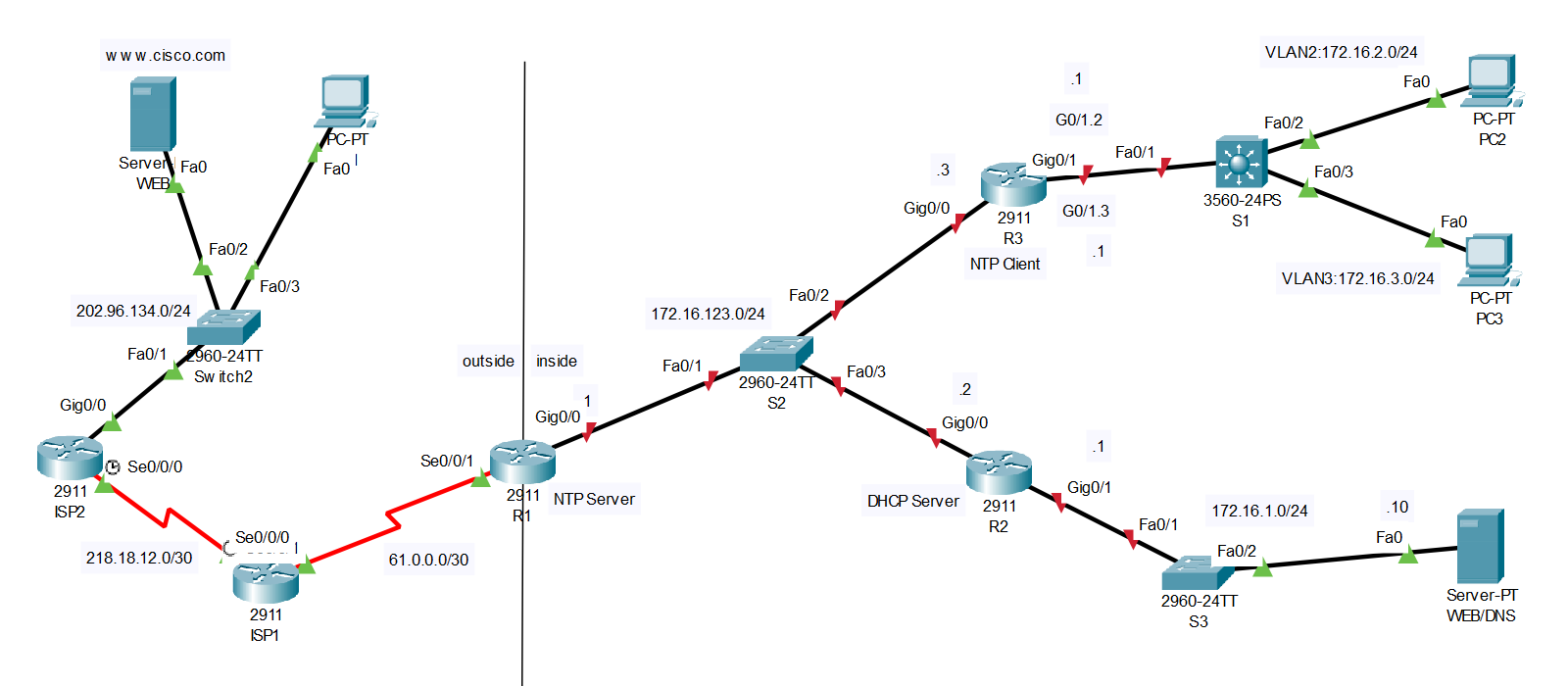
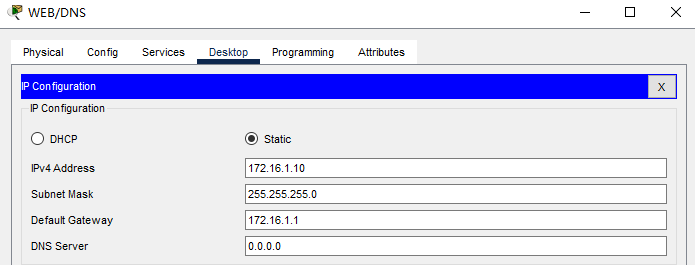
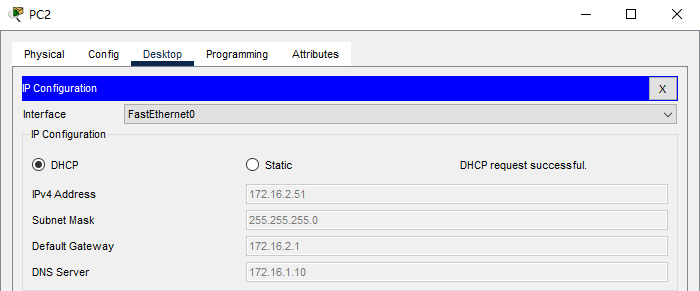
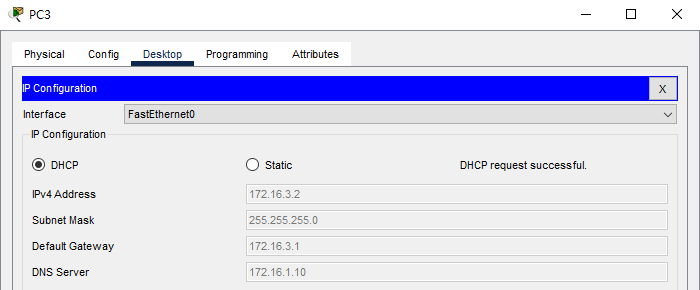
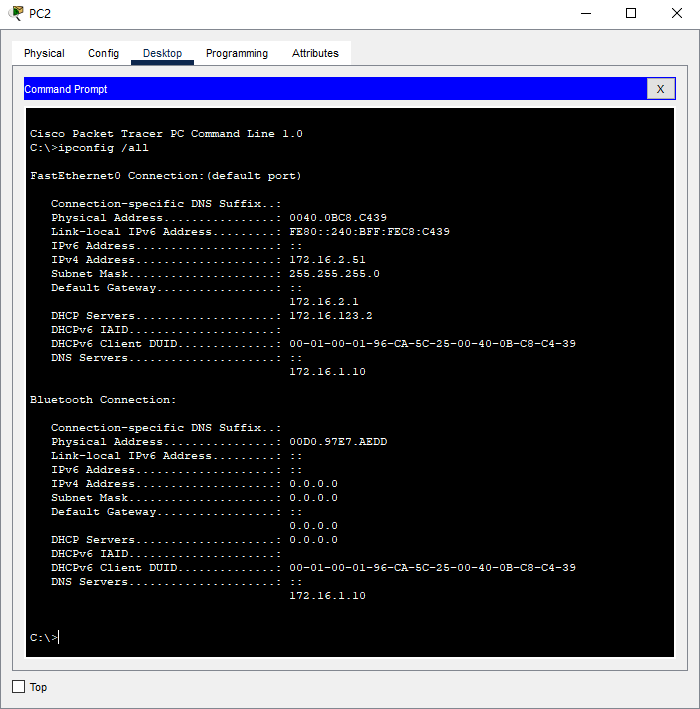
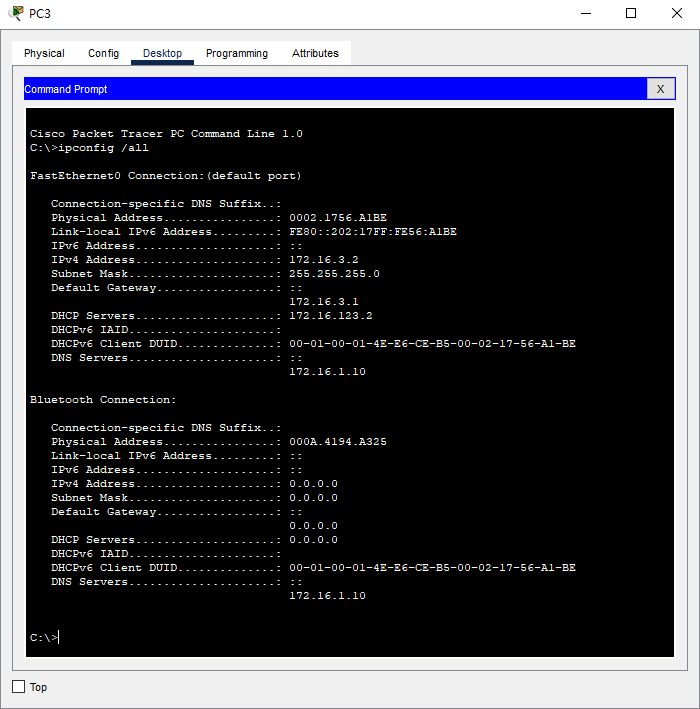
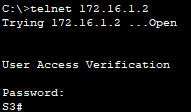
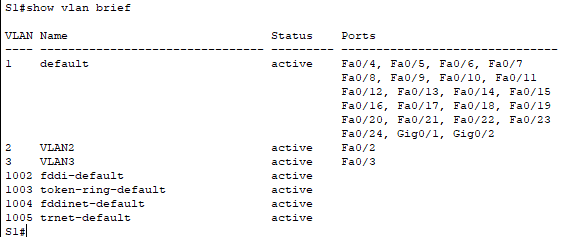




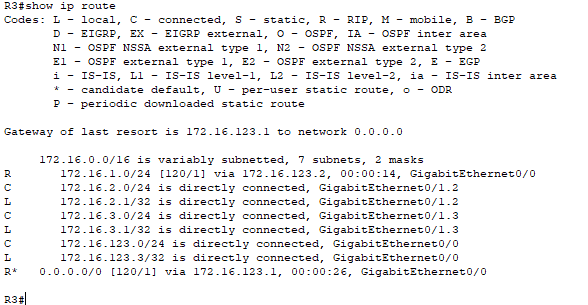


近期评论